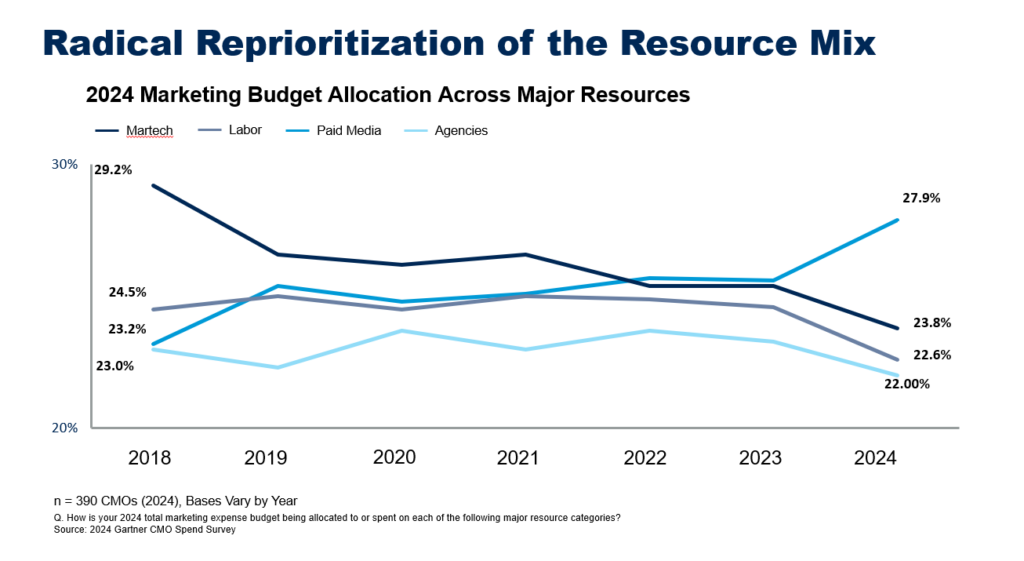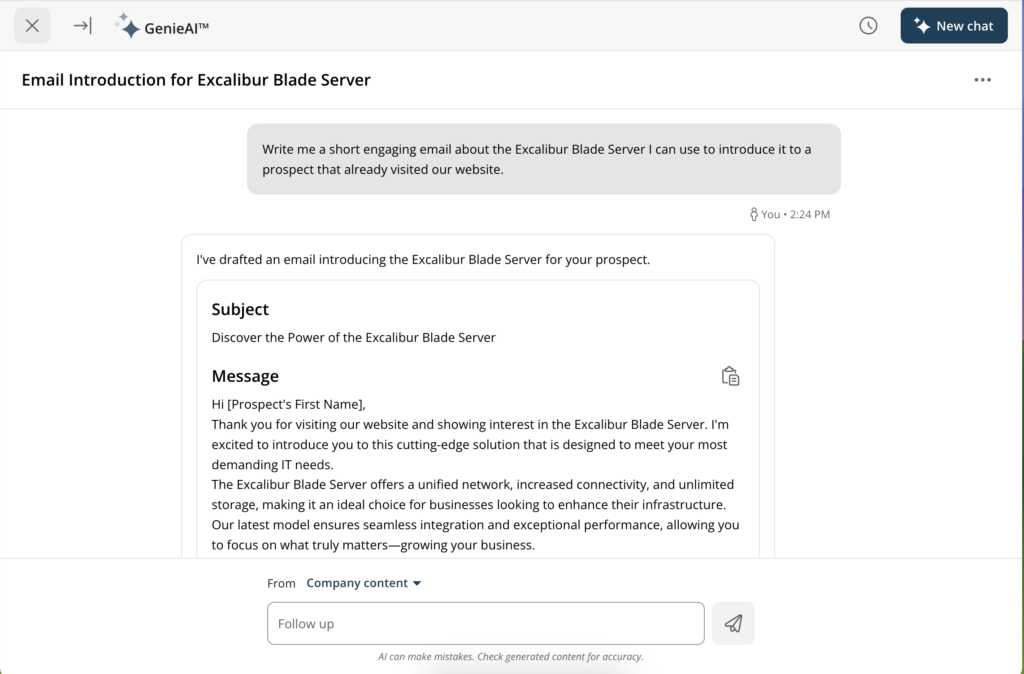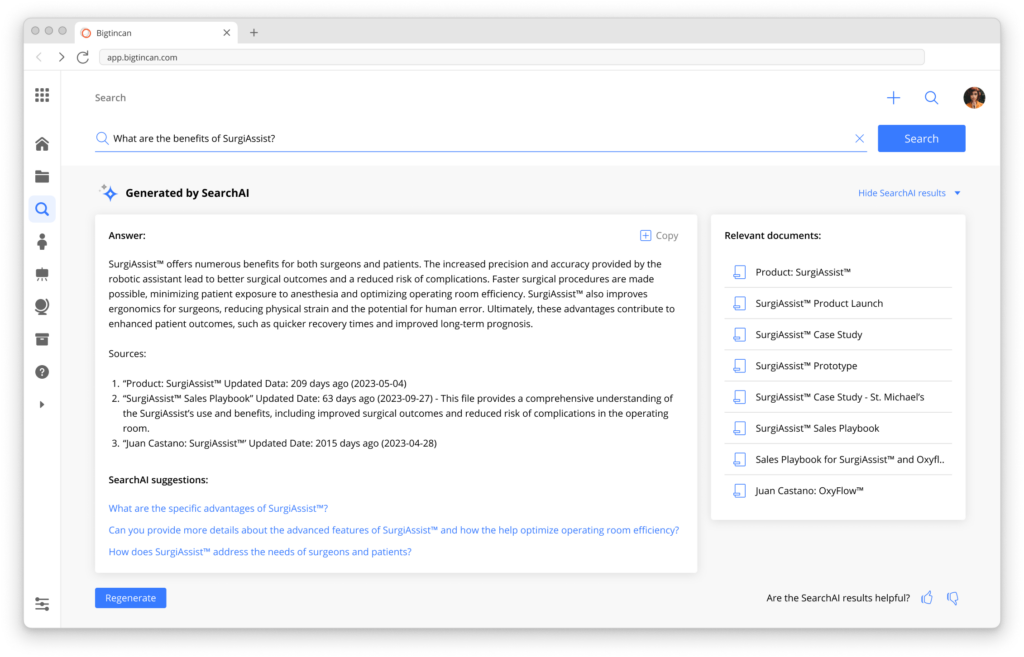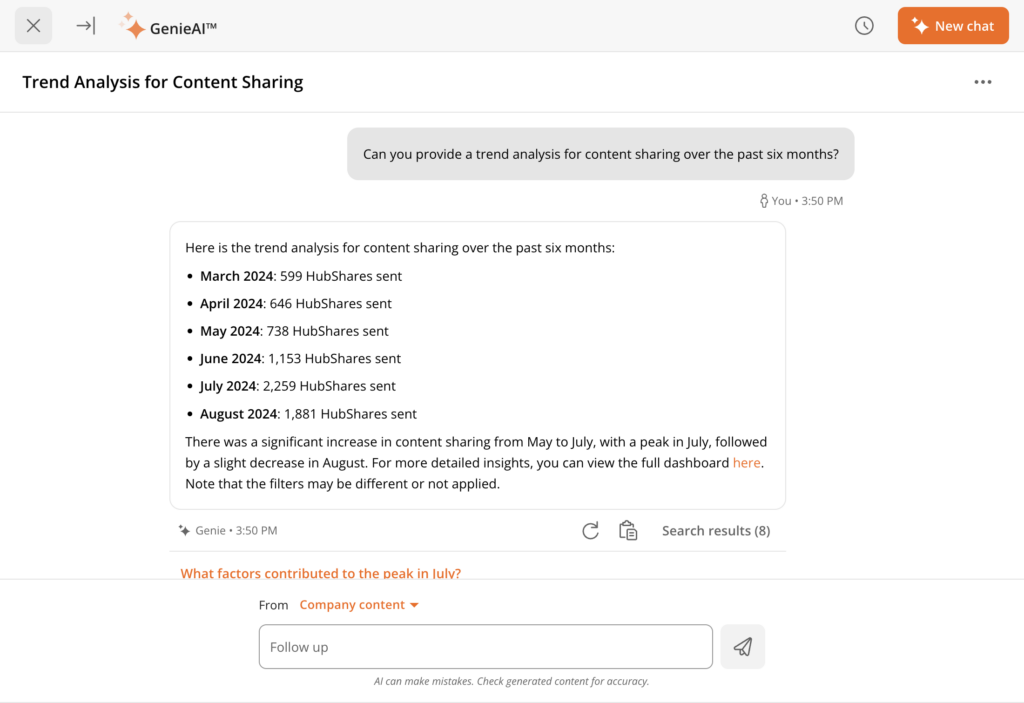Many marketers either fear AI or over-rely on it. Both approaches are flawed.
AI is there to augment human effort — not replace it.
And with marketing budgets tightening, sales cycles lengthening, and the demand for content constantly increasing, marketers need all the help we can get.
In this article, I’ll break down:
- Why AI isn’t the job killer many marketers fear
- Why it might just be the resource we needed all along
- How marketing teams could be using AI more effectively
Please don’t say “Do more with less”
Marketing budgets dropped to 8% of revenue in 2024 (from 11% pre-pandemic). 64% of CMOs told Gartner they don’t have the budget to execute their 2024 strategy. Today’s marketers have been told to “do more with less” so often, it’s become a cliché.

Generative AI has been touted as the solution. By acting as a force multiplier, genAI can boost marketers’ productivity, speed up content creation, and allow for personalization at scale. “GenAI offers the opportunity to grow the marketing function’s impact far beyond its budgetary constraints,” comments Ewan McIntyre, Chief of Research for the Gartner Marketing Practice.
But many marketers fear that AI will take their jobs. And with good reason — marketing spend on both labor and agencies tumbled in 2024, with that budget shifting over to paid media.

But AI doesn’t have to be the enemy. Forward-thinking CMOs aren’t replacing their teams with robots. Instead, they’re giving their marketing teams AI tools so they can skip repetitive tasks, make better decisions, and spend more time on the creative, strategic work that drives real business value.
Marketers who reap the rewards of AI adoption identify areas where AI can enhance efficiency without compromising quality. They commit to maintaining human oversight. They also continuously evaluate the impact on marketing performance and ROI — and invest the time and resources to educate their teams on successful AI adoption.
AI Fear vs. AI Over-Reliance
Marketers who fail to use AI well tend to fall into two extremes: the AI-averse and the AI-enthusiasts.
The AI-averse operate in fear of AI — fear of losing the human touch in their marketing and fear about displacing employees. More than 1 in 3 digital marketers worry about the impact of AI on their job security and responsibilities.
This concern is understandable, but it isn’t helpful. Resisting AI can lead marketers to miss opportunities for efficiency, innovation, and growth, leaving their employers struggling to keep pace with more agile competitors.
How to overcome AI fear
Much of that fear comes from misunderstanding AI’s potential beyond content creation. To overcome it, marketers could start by using AI for other marketing tasks that have nothing to do with content, such as:
- Personalization (tailoring approved messages to specific audience groups)
- Data analytics (surfacing insights from data or trialing predictive analytics)
- Research (summarizing competitor research, customer or ICP data, or product messaging)
Training can also help. Much AI fear is simply fear of the unknown. 38% of employees say that their employers have given them AI tools but haven’t fully explained how to use them. When companies take the time to explain how AI tools work, it can make a big difference in how effectively AI is used across the business.
How to deal with AI over-enthusiasm
AI enthusiasts, on the other hand, over-rely on AI and rush to implement it without a proper strategy or internal guidelines on AI use.
We’ve all seen the potential fallout there, right? From chatbots that write poetry criticizing your organization to terrifying AI-generated images with too many fingers, uncontrolled AI use can leave your brand in shreds.

QSO went viral with this AI-generated social post for all the wrong reasons
To avoid letting AI enthusiasm call your integrity into question, we’d advise asking yourselves the following questions:
- Do your AI initiatives align with your overall strategy and KPIs?
- Have you measured the impact of AI on your marketing performance?
- Are you strategically selecting areas for AI implementation?
You’ll also need a strategic framework to guide how your team uses AI. Because they most certainly already are, even if not officially: The 2024 State of Marketing AI Report found that 99% of respondents say they’re personally using AI in some fashion — and the level of AI usage is rising significantly.
Instead of allowing Bring Your Own AI (BYOAI), put AI usage guidelines in place. For instance:
- Train employees in evaluating the best-fit AI tool for their jobs-to-be-done
- Offer a limited number of approved GenAI tools
- Ask employees to report how they’re using AI, to look for opportunities where a broader AI solution would be useful
Finally, make sure that you use tools (and supply training) that will help keep your marketers on the right side of data regulations. Using AI comes with real business risks, such as data security breaches and intellectual property violations, especially when handling sensitive information via public AI models. Choose AI platforms that come with robust security measures, and give your team ethical guidelines to prevent data leaks and maintain customer trust.
For instance, if you use Bigtincan's GenieAI, you’ll know your customer data is safe. Our SecureGLP™ is one of the most secure AI frameworks out there — so your marketing team can go ham on AI while still complying with enterprise-level data governance standards.
5 practical AI use cases for marketers
There are a bajillion examples of using AI in marketing — from researching and ideating content, to editing, to repurposing transcripts, to auditing content, to targeting, to personalization… Here’s just a handful of approaches from that long list to get you started.
1. Content creation
Over 50% of marketing professionals report that they’re already using generative AI to draft content. While generative AI shouldn’t be relied upon to create final versions of content, it can be an invaluable content assistant. Use it to:
- Brainstorm content ideas by spotting gaps in your existing content
- Produce first drafts that give you a jumping off point (and avoid the dreaded blank page)
- Spot inconsistencies in brand voice, product names, format, and writing style across content in production
- Integrate ideas from multiple teammates into a single cohesive outline
- Repurpose marketing content—for instance, turning product messaging into an email
- Here’s a fun one — let ChatGPT generate some generic headlines or subject lines that give you examples of what NOT to do

📖 Looking for more AI ideas for content creation? Check out our list of 10 AI prompts for marketers that will actually make your job easier.
2. Content personalization
With the proper inputs (messaging guides, brand guidelines, approved content, etc.) AI can do an incredible job of personalization at scale. It conducts the research and can dynamically generate highly compliant content in real-time based on user behaviors and preferences. Use it to:
- Translate mass email campaigns into multiple languages, with different imagery and messaging for each audience
- Offer personalized product discovery based on customer profiles
- Customize content based on the prospect’s journey stage, behaviors, and preferences
3. Surfacing content for sales
For many marketers, the challenge isn’t just creating great content — it’s getting that content into the hands of buyers. 65% of sales reps struggle to find content to share with prospects, while enterprises waste an estimated $2.3 million a year on unused marketing content.
Kathleen Pierce, a Principal Analyst at Forrester, suggests that Sales teams don’t use marketing content either because they don’t know about it, or because it’s stored poorly and they can’t find it.
AI can help make sure your Marketing team’s hard work pays off. Use it to:
- Recommend content to sales reps based on their prospect’s industry or the success of the content in a similar deal
- Automatically surface content in your CRM based on the prospect’s profile
- Give reps content summaries they can use during sales calls
- Surface relevant content assets when reps search your content management system

4. Search Optimization
GenAI isn’t just good at helping marketers create search-optimized content — it’s an excellent technical SEO assistant. Use it to:
- Create optimized title tags and meta-descriptions
- Run content audits and identify keyword or link-building opportunities
- Uncover technical issues on your site, like duplicate title tags, broken pages, or missing image alt texts
- Automate internal linking or optimize page speed
5. Predictive analytics and insights
Marketers using AI-driven analytics are learning new ways to work with data and insights. AI can process huge quantities of marketing data more quickly. It can also respond to questions in natural language, meaning that even non-technical users can now query marketing data and get hold of useful insights.
As a result, AI-driven analytics mean that marketers can now adjust marketing programs in flight, as well as make better decisions about what will work in the future. Use it to:
- Query synthesized customer feedback and customer behavior to inform customer profiles and channel choice
- Segment audiences and get granular insights into what content resonated with each group
- Track content performance in terms of both customer engagement and sales team use, so you know which content formats and topics to double down on
- Generate reports automatically, complete with suggested next actions
- Analyze campaign data to spot underperforming channels or campaigns
- Improve targeting by using intent data and identity resolution mapping

How to get marketing value from AI more quickly
Getting started with AI in marketing might feel a bit overwhelming. You might be worried about AI hallucinations, or feel nervous that you’ll reduce the quality and authenticity of your content. But the best way to start getting value out of AI solutions is to just get started!
To reduce any risks and feel less overwhelmed, we’d recommend that you:
Take a measured approach
Begin with small-scale projects to test the waters. Start by identifying two or three areas where AI could make an immediate difference, and where you’ll be able to notice and measure the impact. These pilot programs can help you understand what works and what doesn't before you dive all the way in.
For example, you could try enhancing your email marketing campaigns by personalizing more subject lines. When Michaels Stores used AI to personalize 95% of its email campaigns (up from a previous 20%) they increased their click-through rate by 25%
Set goals and objectives
Decide how you’ll measure the value and outcomes before you begin. Treat planning and using AI like you would any other marketing tactic. If you're using AI to improve email marketing, for example, track open rates, click-through rates, and overall conversions to gauge its effectiveness. That way, you can quickly test and fail, or test and scale, based on the data you collect.
Do your research
There’s no shortage of content about how to start using AI for marketing today. Start to familiarize yourselves with how other marketing teams are currently getting value from AI. Here are just a handful of resources to get you started:
- AI Tools for Sales and Marketing
- AI Prompts for Marketers
- How Marketers Can Build an AI-Powered Content Process That Enables Sales
- AI Insights: The Content Marketer's Guide
- Using AI to Adjust Your Marketing and Sales in a Volatile World
Think beyond content creation
AI can do so much more than just create drafts of marketing content. Start by looking for time-saving opportunities, like scheduling meetings, summarizing meeting notes, developing outlines for communications, turning content into new assets, or transforming brainstorms into cohesive notes.
AI can help marketers do less — and achieve more
Far from being the enemy at the gates, AI can be a true ally to overworked and underfunded marketing teams. From saving time on tedious admin tasks, to creating content more quickly, AI can help you work smarter.
But introducing AI into your marketing program comes with real risks. To preserve your brand, keep content quality high, and see a genuine return on the time and cost of introducing new tools into your marketing tech stack, you need to take a thoughtful approach. Start with small-scale projects, set clear goals, offer employees training and guidelines, and continuously monitor impact. It’s not about doing more with less anymore — it’s about doing less, but achieving more.
Want to learn more about how AI can help your marketing team improve efficiency and effectiveness, so you can focus on creativity, strategy, and customer relationships? You might want to check out our webinar on AI for sales enablers and marketers.
